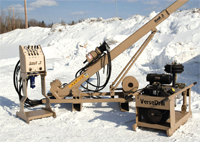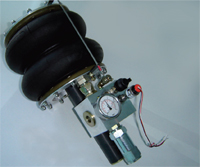Variable-volume reservoir solves weight problem
Hydraulics & Pneumatics, Jan. 15, 2009

Versadrill's KMS0.3 diamond core drill rig uses a Variable Volume Reservoir from Sobacor Inc. to trim almost 95% of the weight from the rig's hydraulic oil reservoir. This is important because the rigs are transported by aircraft, which would otherwise require having them disassembled for transport, then reassembled at the work site.

Sobacor's Variable Volume Reservoir, shown full of fluid and with an instrumentation manifold, can reduce the size and weight of mobile and industrial hydraulic systems without sacrificing performance.
VersaDrill Canada, Val-d'Or, Quebec, manufactures drill rigs and equipment for diamond core drilling. Most of Versadrill's rigs are carried to remote locations by helicopter. Once on site, they are moved to different locations. So, reducing weight of the rigs makes them easier and less expensive to move.
These rigs require powerful drives that are compact and light weight. So, naturally, the need for high power density makes hydraulics the drive technology of choice. But this posed a challenge — how to make the drive even more compact and lightweight.
As with most hydraulic drives, Versadrill's hydraulic systems used a fixed-volume reservoir. The current trend of specifying smaller reservoirs had already been followed, so the challenge was to reduce the reservoir's size even further without reducing performance. Company officials found a solution in a variable volume reservoir from Sobacor Inc., Bois-des-Filion, Quebec. Sobacor developed its Variable Volume Reservoir (VVR) to reduce standard reservoir size and weight, but the VVR also reduces the amount of fluid needed for a system, fluid disposal cost, and potential for contamination.
Substantial weight reduction
Versadrill's previous KMS0.3 drills used a conventional 220-l reservoir. Now, however, they operate with only a 7-l VVR, which reduces the weight by over 550 lb. This amounts to an almost 95% weight reduction of the entire hydraulic system because the reservoir is not only smaller and lighter, but much less fluid is needed. Furthermore, performance has not been affected — and in some cases has actually improved.
As a result, VersaDrill Canada is now evaluating the implementation of the VVR on its larger drill rigs because of the benefits gained on the smaller rigs.
The former rigs had to be dismantled before being carried by helicopter or airplane in order to accommodate the aircraft's maximum takeoff weight. The rigs then had to be reassembled on site, which delayed deployment and added substantial labor cost. The new rigs using the VVR no longer need to be disassembled, which is a huge benefit for Versadrill's customers.
The VVR has been tested and improved for four years on a test stand and is now ready for implementation in mobile and industrial hydraulic systems. The VVRs can be used on many other applications where space and weight are issues. Many other features are involved, such as reduced oil quantity and disposal/environment regulations.
The text above is a corrected version of the original published text which included errors.

